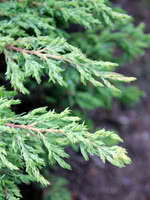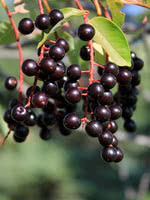Mon-Fri 9am - 5pm Mountain time
Western Chokecherry vs Common Juniper
Juniperus communis
Prunus virginiana var. demissa
NOT AVAILABLE THIS SEASON - MIGHT RETURN
SOLD OUT
Common Juniper is a wide spreading, coniferous shrub with scaly needles and small, berry-like cones. Used as a landscaping shrub, it typically grows 3 or 4 feet tall and will not spread like Creeping Juniper.
You can plant Common Juniper near building foundations or beneath larger trees to provide year-round color and texture to your yard with minimal maintenance.
Western Chokecherry is a shrub or small tree commonly used for farmstead and field windbreaks.
It produces white flowers in the spring and edible dark purple fruit that matures between September and October. Its cherries are great for making for making jams, jellies or wine, but are not very palatable for raw eating.
Common Juniper Quick Facts
Western Chokecherry Quick Facts
Toxicity: toxic to horses, cattle, etc.)

